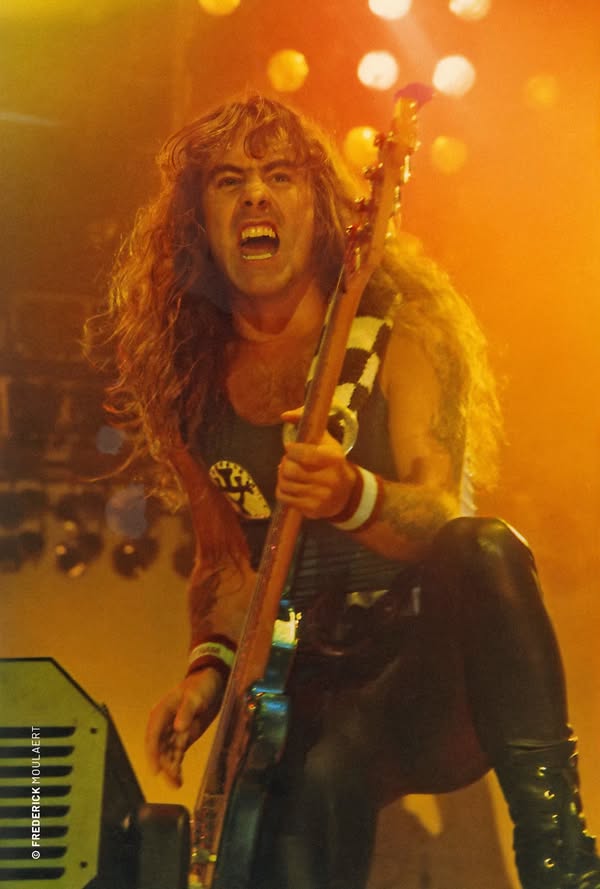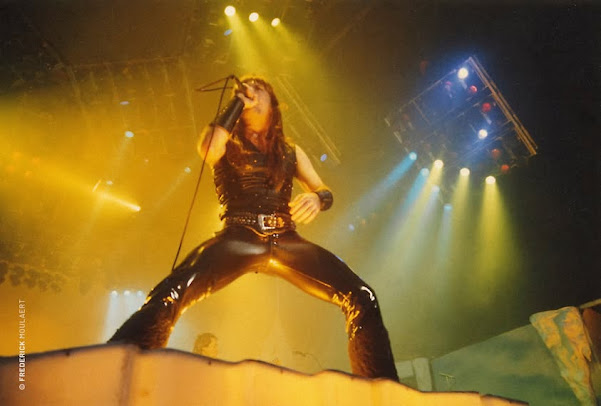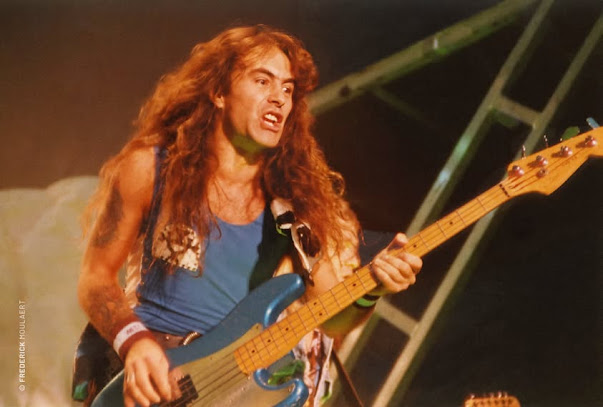Bernie Tormé lasted just over a month in the band. He had just left GILLAN, and despite the structural similarities between the two groups (both were solo groups of former vocalists from legendary seventies hard rock bands), he now found himself in something quite different on every level, which didn't quite convince him. The other case, that of Gillis, took root a little more, remaining in the band for a year, during which he recorded the strange live album "Speak of the Devil." However, he probably didn't see the matter very clearly, and that led him to return to NIGHT RANGER, his longtime band, which, let's face it, had a bonus of being associated with the Ozzy brand.
 |
| Way, Ozzy, Aldridge, Gillis... and the midget! One of the most insane lineups of Ozzy's career. |
As for the other members, things weren't much different. During this turbulent period, bassist Rudy Sarzo and keyboardist Don Airey were replaced by Pete Way and Lindsay Bridgewater, respectively. Pete Way, longtime bassist for UFO, also began a personal drift that continues to this day, and Lindsay B. temporarily resumed the position he had held in the first incarnation of Blizzard of Ozz… Given this situation, it seems perfectly logical that Ozzy declared to KERRANG:
"Since Randy's death, I've had very bad luck with guitarists. They often come to me just looking for fame and a name to use in their respective careers, but I'd like to think that now I'm on the verge of making this a permanent thing, although there are days when I wake up wondering, 'Who's still in the band today?'"
The answer Ozzy was looking for came from two guys named Jackey Lou Williams and Don Costa, guitarist and bassist respectively. The A.R.s who worked for Ozzy's office were in charge of conducting the search, focusing on the West Coast of the United States, perhaps in an attempt to replicate the results obtained with Randy Rhoads, who hailed from sunny California. Both musicians had grown up in San Diego and coincidentally decided to move to Hollywood around the same time, although they didn't know each other at all.
 |
| Don Costa...playing bass with a climbing ice axe! Just what the madman needed. |
Jackey Williams (hereafter Jake E. Lee) had to go through more filters. Before him, the possibility of hiring George Lynch of DOKKEN was considered. Some time ago, before Randy Roahds joined the group, Lynch had been called to join the band, but his manager talked him out of it. Now a second attempt took place, which didn't last more than a couple of weeks, enough time to see that his personality didn't fit. Second possibilities were Jake E. Lee and Mitch 'Perry' Brownstein. Both auditioned at S.I.R. (Studio Instrument Rentals) in Los Angeles, and despite Jake arriving late, after ditching the driver who had come to pick him up, he was ultimately the one who got the job. His mastery of the guitar made up for his informality. As an anecdote, I can't resist mentioning that the other candidate, Mitch Perry, had been in (among many other bands) THE KIDZ, alongside the famous Johnny Depp, a true rocker, before making the leap into film.
Ozzy finally had his band. Don Airey had returned to the group in February 1983, and Tommy Aldridge was still on the drum kit, so it was time to follow the logical sequence, playing as many shows as possible. To achieve this, a tour was logically planned that seemed somewhat strange, since, in reality, what was being promoted was "Speak of the Devil." The set was divided into two halves, the first of which covered songs from his two solo albums, leaving the old BLACK SABBATH classics for the final stretch. Surely, more than promoting the double live show, the goal was to create a connection between the musicians, both technically and personally. This was not achieved. The first to fall, after barely three months in the group, was Don Costa. Ozzy, in the middle of a tour he wasn't enjoying, with Randy in mind and the pressure of the new situation, ended one day in a fistfight with the bassist, for reasons unknown. Ozzy claimed in the press that he had grown tired of him because of his insatiable sexual habits, which made him pay more attention to the women in the audience than anything else. It's no less true that Don Costa was very prone to histrionic posturing, and perhaps his desire for the spotlight tired Ozzy, but in any case, those were known facts, so it doesn't seem like a credible excuse.
 |
| Jake E. Lee |
"The vast majority of the music was mine. 'Rock 'n' Roll Rebel,' 'Bark at the Moon,' 'Now You See Me (Now You Don't)', 'Waiting for Darkness,' 'So Tired'... I would play the riffs I'd written for him, and if he liked them, then the whole band would get to work on them. The fact is that when
I write a riff, I also write the choruses, the solo, the verses, and, in short, the entire song. Bob Daisley sometimes changed something, even Ozzy sometimes adapted this or that part of a song, but that was it.
The only performance that took place with that lineup as part of the "Speak of the Devil" tour was with the group as part of the lineup for the legendary US FESTIVAL on May 29th, alongside JUDAS PRIEST, TRIUMPH, MOTLEY CRÜE, and QUIET RIOT, among others. Right after that show, the band began writing the material for what would be their next release. Coincidence? Let's think so. In any case, what is certain is that the album was written between New York and London, where they settled for subsequent recording at the historic Ridge Farm Studios.
The fact that they used the same studio as their previous album, "Diary of a Madman," and that the personnel were also the same (Max Norman as engineer and producer, and even Louis Clark on the string arrangements) gives one pause. Was Ozzy really intending to embark on a new era? Is "Bark at the Moon" so different from its predecessors? Each of us will undoubtedly have our own opinion. Mine, in case anyone's interested, is that what emerged from those sessions was a bridge between a past marked by a very personal sound and a future that Ozzy (or rather, those around him) knew how to foresee, anticipating events. I find a lot of his earlier work in songs like "Rock and Roll Rebel" (a real statement of principles and one of the album's highlights) or the lightning-fast and sinister "Forever," which opened the second side of the vinyl with a sinister Don Airey intro that still resonates with him today and could be a sequel to the one he wrote for the classic "Mr. Crowley." The same could be said of the title track, "Bark at the Moon," which is already a milestone in rock history, just as "Crazy Train" and "I Don't Know" were in their day. They were songs that retained the "attack" of European hard rock with an American style of songwriting, riddled with choruses and riffs you'll remember for a lifetime.
However, there are other songs that have a very different flavor, one that would remain present throughout Ozzy's discography for the rest of the decade. I'd include "Waiting for Darkness," with entirely new arrangements compared to what they'd seen before, the strange "Spiders," and the no less disturbing and paranoid "Now You See Me Now You Don't," capable of unnerving even the most seasoned rocker. There are also a pair of magnificent mid-tempo hits, "You're Not Different" and "So Tired." The former is a brilliant standard of the era, and the latter defies any comparison, although its orchestrated parts recall KISS's legendary "Beth."
Truly, after the devastating blow of Randy's death and the downward spiral the Madman took over the next two years, I think it would be unfair to say that (by comparison) their new release was a step backward. What did represent a setback in the band's progress were a series of less-than-wise decisions that led them to repeat the grotesque situations they'd experienced in the recent past. The most notable was putting Tommy Aldridge on the road. Everyone knew Tommy's strong suit was the stage. There, the drummer performed with an ease that didn't shine nearly as brightly in the studio. In fact, before joining Ridge Farm, the possibility of hiring a musician was considered, but ultimately it didn't come to fruition. Tommy recorded the album, and when it came time to tour, he was fired. If anyone understands this, please explain.
 |
| Carmine "The Fleeting" Appice. |
His place was filled by the legendary Carmine Appice (CACTUS VANILLA FUDGE, Rod Stewart, etc.), a name who was a star in his own right and who, predictably, didn't work out. Apparently, there were some ego issues, as Carmine was sought out by crowds of fans every night to sign autographs. The drummer (or his manager) saw a business opportunity and asked permission to sell his T-shirts. Sharon agreed, which was more than surprising, but the real surprise was that the fearsome manager had ordered that Carmine's face be cut out of their own t-shirts! In total, those garments basically consisted of a hole with sleeves. The veteran drummer got the hint and in February 1984, just as the US tour had begun, he packed his bags and left. And... who will you say replaced him to tour the United States? Yes, it was indeed Tommy Aldridge, the only one who was missing to become a permanent replacement like Don Airey and Bob Daisley. The old habits of changing personnel at the last minute returned to the band (if they ever existed).
"At that moment, we knew that, wherever we were, whatever we did, there would always be someone sicker and filthier than us.”
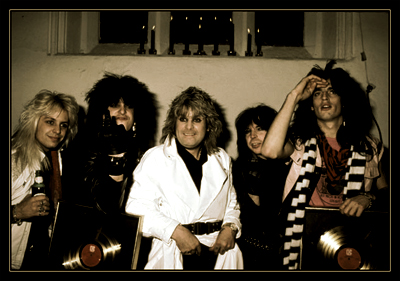 |
| Danger! Danger! Danger! |
However, it's only fair to quote another quote from that book, which goes some way to sum up the enormous impact that OZZY OSBOURNE (the band) and "Bark at the Moon" (the album) had on the music scene of that time. Those of us who saw all this from the outside didn't appreciate it, of course, but Nikki Sixx's appreciative comment pretty much defines who Ozzy was in 1984:
"If the performance at US FESTIVAL was the spark that lit what we could become (MOTLEY CRÜE), the tour with OZZY was the match that lit the band on fire. Without it, we probably would have ended up being one of those L.A. bands, like LONDON, stars that never quite shined."
I think that's pretty clear, right? Anyway, all that remains to be said is that during the "Bark at the Moon" tour, OZZY OSBOURNE was part of the most renowned Heavy Metal festivals, especially in Europe, where he participated in the DORTMUND FEST, the MONSTERS OF ROCK in Donnington, and the BREAKING SOUND FESTIVAL in Holland. With this album also in stores, albeit very late (in January 1985), he put his name on the monumental "Rock in Rio" (the real one), alongside YES, QUEEN, IRON MAIDEN, WHITESNAKE... in short, the crème du la crème of world rock.
Gone are the days when every step these figures took was surrounded by legendary names, unrepeatable festivals, and top-tier musicians... Times change, and in this case, not exactly for the better, but at least we have the consolation of putting this album on and howling at the moon for a while…
/Miguel Asturias








.jpg)

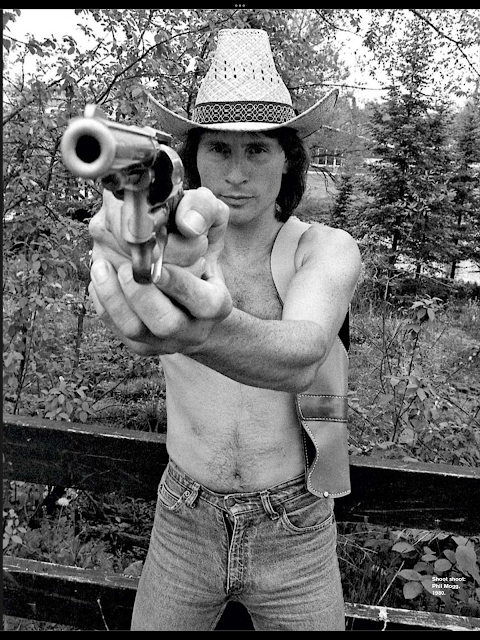

.jpeg)



%201:2.jpeg)
%202:2.jpeg)
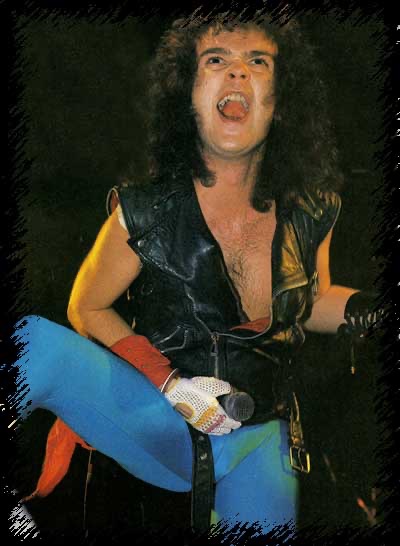









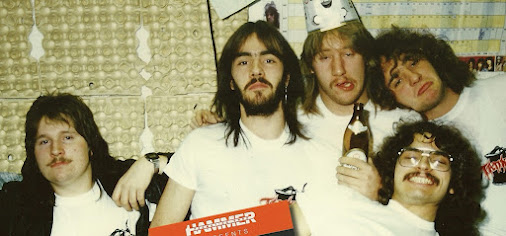
.jpg)




.jpg)





